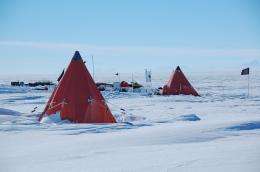Drilling into the unknown -- the first exploration of a sub-glacial Antarctic lake is a major step closer

(PhysOrg.com) -- Scientists have located the ideal drill site for the first ever exploration of an Antarctic sub-glacial lake, a development that it likely to facilitate a revolution in climate-change research and which may lead to the discovery of life-forms cut off from the main line of evolution for millions of years.
In a paper published in Geophysical Research Letters this week, scientists from Northumbria University, the University of Edinburgh and the British Antarctic Survey have revealed the optimal drill site for exploring Lake Ellsworth, a sub-glacial lake comparable in size to Lake Windermere which is covered by three kilometres of ice.
No one has yet drilled into an Antarctic sub-glacial lake. But microbiologists believe that such lakes could harbour uniquely adapted life-forms cut-off from other lines of evolution. Paleoclimatologists also suggest that sediments on the lake floors could contain records of ice sheets and climate history that would revolutionise research into global warming.
In order to access the lake water and the undisturbed sediment containing the climate record, it is essential to drill in the right place.
The optimal drilling site has to avoid possible areas of in-coming water that would disturb the sediment, as well as areas of so-called basal freezing — where lake water freezes to the underside of the ice. It also has to avoid any concentrations of trapped gases which could rush up the bore hole to cause a potentially dangerous blowout at the surface.
The Scientific Committee on Arctic Research identified Lake Ellsworth as an excellent candidate for the first drill site.
Dr John Woodward, from Northumbria University’s School of Applied Sciences, commented: “The location provides a deep water column for sampling and reduces the risk from possible basal-freezing mechanisms. It optimises the chances of recovering an undisturbed, continuous sedimentary sequence from the lake floor, and minimises the potential for trapped gases to gain entry to the borehole.”
Dr Andy Smith of the British Antarctic Survey added: “This is an eagerly-anticipated result -- the final piece of the jigsaw that we need to plan the exploration of Lake Ellsworth. That exploration can now go ahead at full speed.”
To locate the optimal drill site, the team had to conduct the first detailed characterisation of the physiography of a sub-glacial lake. Between 2007-2009, the lake was subject to a ground-based geophysics campaign involving an ice-penetrating radar to investigate ice thickness, seismic surveys to calculate lake water depths and flow measurements to calculate how the ice sheet flows over the underlying lake.
The climactic stage in the project will take place in the 2012-13 Antarctic summer when the Lake Ellsworth Consortium will use the data in this paper to access a sub-glacial lake for the first time.
Professor Martin Siegert, of the University of Edinburgh’s School of GeoSciences, said: “Pinpointing the perfect spot from which to access the sub-glacial lake helps us to find out all we can about this interesting and pristine environment, without the risk of contaminating it.”
Provided by British Antarctic Survey















